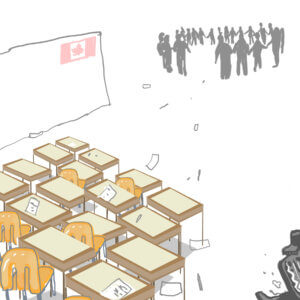Adapted from a conversation with Doreen Richard, Mount Allison’s coordinator of Indigenous affairs
Doreen Richard once taught a boy who was repeating a grade in a Grade 5/6 split classroom. “I looked at his transcript,” she said, “and I knew this kid was capable.” Knowing this, Richard struck a deal with the principal. If she could get him through all the Grade 5 material by Christmas, he would be moved up to Grade 6 for the remainder of the year. By November, he had passed the Grade 5 requirements “with flying colours. [She] knew what things were like at home,” so she began to set up an environment conducive to his learning. Every day after school, she would have some cookies and milk for him. “Get something to eat,” she would tell him, “and let’s get to work.” He went on to graduate high school and attend Saint Mary’s University in Halifax.
The aim of this article is not to demand support for the cause of Indigenous education. Instead, it is to communicate the views of an expert in the area and to shed light on how to address it. Two central causes for the disparity in quality between the public and Indigenous educational systems are the high turnover rates of teachers and the legal framework that keeps Indigenous students in those schools.

New teachers on reserves tend to be afraid of the conditions in which they must teach and are fully aware that students often will not come in on time with finished homework or refuse to, say, take coats off indoors. As a result, Indigenous schools see a higher-than-average turnover rate of teachers. “Think about the home environment. Maybe a child doesn’t want to take off their coat because there’s no washing machine in the house and their shirt smells,” said Richard. “A child may not have finished her homework because a loud party near their home went on all night.” Richard sees a simple solution: hiring more Indigenous teachers, as they were often raised in such environments and can better understand the reasons students sometimes are unable to comply.
The number of Indigenous teachers is closely connected with the quality of Indigenous education as a whole. A high school diploma is required to apply for a bachelor’s degree, which is required to apply for a bachelor’s of education. This means a nudge in the number of Indigenous teachers who go back to teach on reserves could improve the quality of education on reserves, leading to more high school and university graduates, and more certified Indigenous teachers returning to teach on reserves. “Now there’s more and more people going to university, getting their bachelor’s of education, and going back to their communities.”
Richard presents another problem. “When you have a school in a community, it’s federally run. We’re controlled by the federal government,” said Richard. If a student wishes to travel outside of the community to attend a specialized program in another, provincially-run school, the community must pay a steep cost to subsidize that child’s education. Reliance on the federal government makes it difficult for communities to take ownership of their educational institutions (in curriculum development, renovations, hiring, and so on). When asked whether moving these schools under a provincial jurisdiction would help improve their state, Richard replied, “we would lose the little control that we have over our children’s education.”
This view is shared by many Indigenous students on campus. “Our culture was intertwined with our program,” said Thunder Nevin, a first-year student and former attendee of Elsipogtog School. The Indigenous teachers at his school had no hesitation to discuss Indigenous culture “when it came to why we smudge, why we pray, [and] all these legends and stories.”
The federal government has also made efforts to grant Indigenous communities more autonomy in administering their educational institutions. In 2016, the federal government, in partnership with the Manitoba First Nations Education Resource Centre, announced the creation of the Manitoba First Nations School System, a network of schools with curricula designed by Manitoba’s Indigenous communities.
All in all, the issue of substandard living conditions on reserves is complex and multifactorial, but improving the quality of education through increased autonomy in curriculum design and bolstered numbers of Indigenous teachers is a tangible, realistic measure that can be taken. After all, the first step in solving any tough problem is to understand its root causes.





